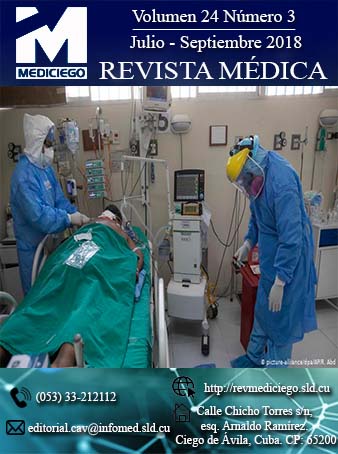Características clínicas, epidemiológicas y metabólicas en diabéticos tipo 2 recién diagnosticados con insulina como terapéutica transitoria
Resumen
Introducción: en los enfermos con diabetes mellitus tipo 2 el tratamiento inicial con insulina es una modalidad terapéutica utilizada.
Objetivo: caracterizar clínica, epidemiológica y metabólicamente los enfermos de diabetes mellitus tipo 2 con uso transitorio de insulina luego del diagnóstico.
Método: se realizó un estudio observacional descriptivo prospectivo en el Hospital General Provincial Docente de Ciego de Ávila durante el período de mayo 2015 a julio 2016. De una población de 131 enfermos de diabetes mellitus tipo 2 se tomó una muestra intencional de 67, a los cuales se les indicó insulina de forma transitoria luego del diagnóstico.
Resultados: la edad media fue 48,90 años. Predominaron las mujeres (56,71 %) y el antecedente familiar (94,02 %). La dosis media de insulina fue de 29,60 ± 6,20 Ud/día en 42,90 ± 9,3 días. Se produjo mejoría significativa entre el inicio y seis meses: índice de masa corporal (30,80 ± 2,3-28,60 ± 2,06); circunferencia de la cintura abdominal (hombres 108,3 ± 7,8-103,30 ± 6,20 cm y mujeres 103,60 ± 7,10-100,10 ± 5,70 cm); glucemia en ayunas (13,60 ± 1,30 mmol/L y PP2h: 22,10 ± 2,80-10 ± 0,70 mmol/L y 7,90 ± 1,10 mmol/L) y hemoglobina glucocilada (8,70 ± 1,10-6,90 ± 0,60 %). Las hipoglucemias fueron pocas: 2,90 % moderadas y 5,90 % ligeras. La casi totalidad se mantenía controlada con metformina a los seis meses (92,54 %).
Conclusiones: los resultados confirman que con el uso inicial transitorio de insulina se logra un control glucémico adecuado, mantenido posteriormente con monoterapia de metformina
Descargas
Publicado
Cómo citar
Número
Sección
Licencia
Derechos de autor 2021 Yohannys Cajigal Pelegrin, Odalys Arguelles Martínez, Maikel Roque Morgado, Eduardo Artiles Pardo

Esta obra está bajo una licencia internacional Creative Commons Atribución-NoComercial 4.0.
Aquellos autores/as que tengan publicaciones con esta revista, aceptan los términos siguientes de la Licencia CC Attribution 4.0/ International/ Deed (CC BY 4.0):
Usted es libre de:
- Compartir — copiar y redistribuir el material en cualquier medio o formato para cualquier propósito, incluso comercialmente.
- Adaptar — remezclar, transformar y construir a partir del material para cualquier propósito, incluso comercialmente.
La licenciante no puede revocar estas libertades en tanto usted siga los términos de la licencia
Bajo las condiciones siguientes:
- Atribución — Usted debe dar crédito de manera adecuada , brindar un enlace a la licencia, e indicar si se han realizado cambios . Puede hacerlo en cualquier forma razonable, pero no de forma tal que sugiera que usted o su uso tienen el apoyo de la licenciante.
- No hay restricciones adicionales — No puede aplicar términos legales ni medidas tecnológicas que restrinjan legalmente a otras a hacer cualquier uso permitido por la licencia.
La revista no se responsabiliza con las opiniones y conceptos emitidos en los trabajos, son de exclusiva responsabilidad de los autores. El Editor, con la asistencia del Comité de Editorial, se reserva el derecho de sugerir o solicitar modificaciones aconsejables o necesarias. Son aceptados para publicar trabajos científico originales, resultados de investigaciones de interés que no hayan sido publicados ni enviados a otra revista para ese mismo fin.
La mención de marcas comerciales de equipos, instrumentos o materiales específicos obedece a propósitos de identificación, no existiendo ningún compromiso promocional con relación a los mismos, ni por los autores ni por el editor.






















